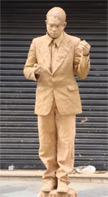By Jim Selman | Bio
I just saw the movie WALL-E about a lonely robot on planet earth 700 years after a Wal-Mart-like enterprise wins the game of mega mergers and is the only corporation left, effectively running the world. The people had to leave because they couldn’t keep up with the trash. WALL-E (Waste Allocation Load Lifter – Earth Class) spends its days (we soon begin to think of it as a ‘he’ thanks to some brilliant scripting and Pixar magic) creating skyscraper-scale mountains of trash. It is a great film and brilliantly delivers ‘social responsibility’ messages while telling a beautiful love story that meshes with some profoundly human moments when people wake up to the possibility of having a choice combined with responsibility for cleaning up the mess we made in the 20th and 21st centuries.
For a long time I have had the view that 99% of our human dilemma can be attributed to the Cartesian worldview that declares “I think therefore I am”, which effectively turns human beings into things that think. It also pretty much destroyed any distinction between the ‘self’ and the ‘mind’. We came to believe (mistakenly) that we are our thinking and that we are in control of what we are thinking. This made sense in a time when the Church and Science were dividing up the world and agreed that Science could have the ‘stuff’ (all things physical) and the Church would take the ‘spirit’ (all that is not physical). The problem was that Science needed some way to deal with people in scientific terms, which meant defining a person as an object subject to all the physical rules of the universe. Psychology became the ‘operating manual’ for how the ‘thing’ works, Management became the ‘science’ for controlling the things, and Economics pretty much accounted for our design function—buying and selling.
This worldview gave us a lot of power for a long time. As we learned more and more about our physical world, we also learned more and more complex ways to control our environment (or at least to have the appearance of control). But if we extend this way of seeing ourselves and our relationship to the rest of the world, we also are viewed as mechanisms that are constantly reacting (rather than acting) and become controlled by the very things we created to give us freedom and control. We become literally ‘addicted’ to our view of the world and keep doing the same things over and over expecting different results. After seeing WALL-E, the line between humans and machines becomes very blurry even if it is just a story—but then again, isn’t everything just a story?
If I extrapolate some of this thinking to aging, it becomes clear that a lot of our thinking is shaped by the ‘thing’ metaphor for who we are. Basically aging is wearing out. There may be a few ‘special’ antiques that we value, even revere, but for most of the stuff, it is just disposable and not worth much at some point. Send us to the landfill and get a new model.
Most of the alternatives—and specifically ‘Eldering’—require we clearly declare that ‘I am not a thing’ and reclaim our capacity as creators and as possibilities and as the ‘choosers’ in this process of life. For this we must begin to ‘own’ or be responsible for the whole system—actually the whole worldview—and let our commitments drive our communication and coordination wherever we are participating. George Bernard Shaw once said, “Reasonable people adapt themselves to the circumstances, Unreasonable people adapt the circumstances to themselves”. In the movie, we watch a loveable little robot become unreasonable and, in doing so, transform human reality from resignation and indolence into possibility.
Our generation, in many ways, is the bridge between two worlds—a world where science ruled and success was a function of ‘material’ accomplishment and a world in which human beings are learning to play a different game based on ‘spiritual’ values where success is a function of love. Perhaps our greatest gift to the next few generations will be showing them that they have a choice—the choice to choose, to not just be a thing that thinks.
© 2008 Jim Selman. All rights reserved.

